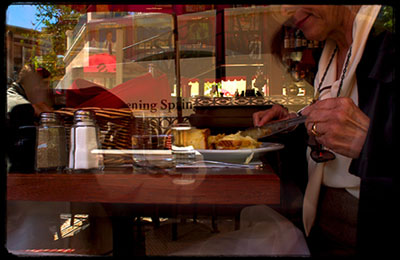THE STILL IMAGE IN REAL TIME.
by Pedro Meyer
 |
Pedro Meyer © 2003 |
|
|
So my phone takes a picture, what changes does that forebode for photography you will ask. Well, look at it this way, over the past year (2003), the number of cameraphones sold world wide has been larger than the number of stand alone digital cameras, and no doubt the trend will continue into the future. By next year (2004) the number of camera-phones sold is expected to be greater than the number of digital and film cameras combined. The amount of pictures that are being taken and sent to someone across the globe is growing exponentially and the images are being shared by someone, namely by you. That is what is happening, and this party has not even started. I have always found the expression a "picture is worth a thousand words" to be rather inappropriate because we don't know whose picture and whose words we are comparing, but I must admit that in general terms, the amount of information that a picture conveys is pretty accurate in terms of the wealth of data. If you send just one picture over a phone, it would take you probably a thousand or more words to describe all that there is within that very same image. The possibility of sending this wealth of information at the click of a button, is what makes the experience of digital picture making so fulfilling, as well as efficient. My friends Bob Goldstein and Alexis Gerard suggest that sales of camera-phones will approach 50 million units in 2003, while only 32 million stand alone digital cameras and 60 million film cameras will be sold worldwide. Are we on to something here? Could it be that the photographic community might be dismissing yet again another technology as "just a toy" as was the case with the first digital cameras? There are already camera-phones that are starting to deliver 1 to 2 mexapixel images, that should tell you something about the level of resolution that some of these images are going to be arriving at, maybe during your next cell phone call or on your computer via the internet. We should understand that with the camera-phones entire new photographic endeavors will emerge. We should not always judge the future by that which we already know, on the contrary, the exciting thing is to imagine what we do not yet know or even fully understand. For instance, how will people use the camera-phone? Possibly to create their personal diaries in new ways that have not been done in the past, it's quite an intriguing proposition in spite of diaries not being something very new, in fact it is quite ancient. But what keeps it alive is that it is so human and so basic to our personal interactions. The potential to find new forms of delivery and construction (internet+ camera-phone images) is what offers such a great challenge to our imagination. But what about someone who is out shopping and wants to confirm if the chair they are about to buy is the right design? Or if the pattern on the textile is the right one for their curtains? You can save yourself a lot of additional trips by just confirming via picture phone if what you need really is what you are being offered. Then we have all those blind dates, they no longer need to be so blind! There can be a picture phone going on in either direction. We understand that escort services, also want for security reasons, to get a picture of their clients ahead of time, something that works to the benefit of both parties as security is sought by one side and "good looks" by the other, both seem to benefit from visual confirmation. Photography has always been based among other ideas, on the notion of being a witness to an event. The desire to use the camera as a tool to mediate the world of the photographer in bringing the image to the viewer. However still photography was never delivered in real time, as could be the case with broadcast television. Now for the first time, the still image is in real time. The phone-camera, and the digital camera over the internet. We are looking at something completely new, the delivery of the still image in real time. In the past, the time lag between taking a picture and showing it went from months, then to weeks, following that it went to days, and then to hours, and more recently to minutes, finally now we have for the first time all of this happening in real time. The implications for all of photography are of course huge. When photography can be in real time, we will discover that we have to reconsider many of our traditional notions of what photography has stood for, and how it was delivered. Some new forms of delivery will emerge, others will tend to disappear, it is yet too early to tell, which ones. What is clear is that the world of photography is not going to remain the way it was only a decade ago. Pedro
Meyer Please share your comments on this issue with us in our forums. |